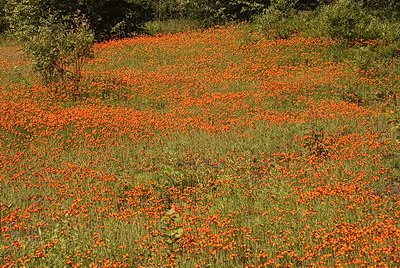
Treatment of Invasive Species: Best Practices for Successful Management (Large site of Orange Hawkweed. Photo credit: ontariowildflower.com)
It will come as no surprise to many people nowadays that the spread of invasive species poses a real threat to our local ecosystems and economies. Across BC, there are several weed committees, like the Lillooet Regional Invasive Species Society (LRISS), who are working hard to combat these invading plants and animals. What is little known though, is just how the decisions are made to tackle these invasives. In order to be as effective and efficient as possible, management goals need to be prioritized. Making decisions on what species and sites to treat are based on numerous factors, including:
- Biology - including the aggressiveness of the species and its ability to spread
- Abundance - focusing on species that are not yet within an area or have a small distribution rather than those species that are 'everywhere'
- Impacts - what is the risk to health, agriculture, ecosystems or other land values
- Ease of control - small budgets may be better spent on species that have a high likelihood of being effectively controlled
- Risk assessments - of the species from BC or other regions
Also, in most areas of BC, regional invasive species committees have developed invasive species priority lists to help inform the prioritization of activities.
Once an invasive species and site is prioritized for treatment, a treatment method needs to be determined. Choosing an appropriate treatment method depends on the biology of the species, size of infestation, characteristics of the site, goal of the treatment (eradication or control), cost, time involved, and impact of the species and the treatment method to the area. With all of these variables to consider means that there is no one solution to every problem species or site. Most decision makers have a toolbox with several available tools to choose from. Using an integrated approach, such as with an Integrated Pest Management system, ensures the likeliest chance of success to any project. Integrated pest management (IPM) treatment options include:
- Mechanical - mowing, digging, clipping seed heads, hand-pulling, and cutting. This method is most effective on smaller sites.
- Cultural - replanting or reseeding, irrigation, fertilization, crop rotation, shade to. This method focuses on modifying the invasive plant’s habitat to promote desired plants and minimize invasive plants from becoming reestablished.
- Biocontrol - Involving using natural enemies, either insect or disease causing organisms, to suppress the growth of, or kill the invasive plant without harming other non-invasive plants in the area. This is a long-term control method that is usually slow to take effect and is limited to specific invasive plant species in BC. It is cost-efficient, particularly on large sites. (Knapweed Biocontrol - Larinus obtusus)
- Herbicides - use of chemicals to suppress growth or kill plants. It is important to use extreme caution when using chemical herbicides.
Getting expert advice will help you understand the rules to make informed decisions and hiring a certified applicator will help ensure that the chemicals are used safely and appropriately.
Once invasive plants have been removed, the work is not done! It is so important to have posttreatment activities to prevent further infestations.
This includes:
- Reseeding or replanting site with desired vegetation capable of resisting re-invasion and creating a competitive cover
- Minimizing future bare soil or disturbance at the site
- Monitoring site for invasive plant regrowth
- Maintaining healthy vegetation base (e.g. native grasses or other plants)
LRISS uses these treatment methods in combination, as needed, in an integrated approach making IPM the most effective way to manage invasive plants and providing the best chance of success to their invasive plant management system.
For more information, you can email LRISS lrinvasives@gmail.com. You can also find us on Facebook or Twitter.